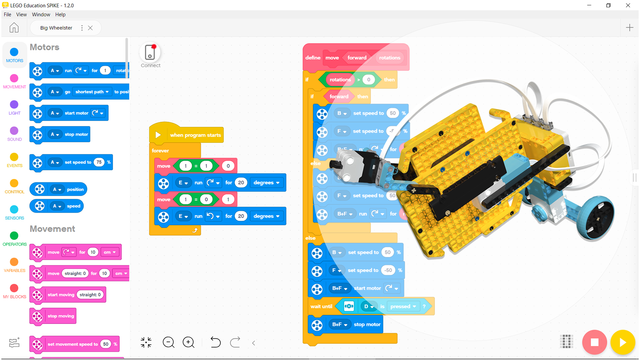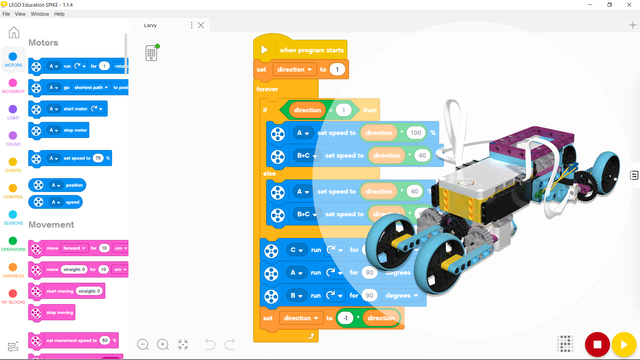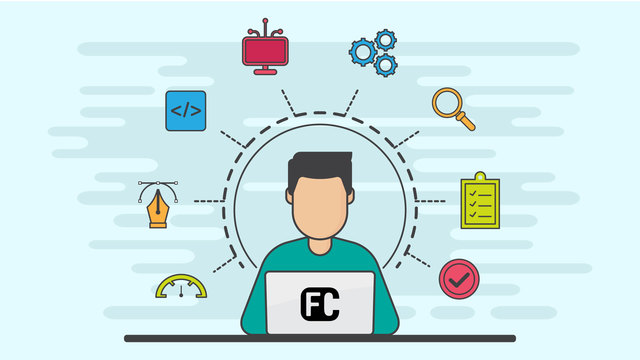
FLL 2019: Program for The City Shaper Swing (07) Robot Game Mission
Program for the FIRST LEGO League 2019 City Shaper Swing mission. The attachment is attached on the robot and it we just start the program
- #7cld4p
- 07 Aug 2020

Program for the FIRST LEGO League 2019 City Shaper Swing mission. The attachment is attached on the robot and it we just start the program

EV3-G program developer for the FIRST LEGO League 2019 City Shaper Elevator Mission. The robot calibrates the possible of the attachment and then moves forward and backward to complete the mission

This program is for the target part of Pallo. It uses a piston with differently colored sections, which are detected by a color sensor.
The piston starts with a green section, so the program waits for that color to change—indicating that the target has been hit. Then, it celebrates!
The celebration is simple: the program reads the color of the new section to determine how accurately the target was hit, and it lights up the center button with that color. It also displays "YAY" on the hub's screen.
Feel free to improve the program however you like!

This program is designed for the Calix – LEGO SPIKE Prime carrying robot. Calix is built to carry an object while autonomously following a black line.
This concept is one of the first things many people imagine when thinking about robotics—a robot that can assist at home!
Calix is a simple, first attempt at turning that idea into reality. It can transport light objects from one room to another by following a predefined black line.
The program operates as follows: First, it waits for you to place an object on the robot and press either the left or right hub button. Once triggered, the robot lifts the object slightly and begins following the black line. It continues along the path until it detects the same color consistently for more than 3 seconds—this is how it knows it has reached the end of the line. At that point, the robot raises the object higher and waits, holding the item securely in place.

This program makes the Tohuru – LEGO SPIKE Prime Owl Robot move like an owl! But what does an owl move like? Well, we figured a key part of an owl’s behavior is firmly holding onto a branch. So, the first part of the program makes the robot grip tightly onto whatever is between its two wheels. After that, the owl begins spinning its head and searches for the closest object. Once it finds something, it stares at it—menacingly—until it moves away!

This program makes the Big Wheelster – LEGO SPIKE Prime robot move forward until it bumps into something! This robot features one big wheel powered by two Medium Motors. What’s interesting is that the motors must spin in opposite directions to make the wheel rotate. That’s why we’ve created a My Block to control the robot.
The My Block allows you to set how far the robot should move—either a specific number of rotations or indefinitely (by setting it to 0 rotations). It also includes a logic option for direction: use 1 for forward and 0 for backward.
When the robot detects a bump using the front touch sensor, the program makes it reverse using the back wheels, helping it avoid hitting the same obstacle again!

This program makes the Swing Game - LEGO SPIKE Prime robot move the two LEGO figures based on input from their respective controllers.
The color sensor controller uses the colored plate above it to determine movement. If the sensor detects blue, the LEGO figure moves forward. If it detects purple, the figure moves backward. Any other color will make it stop.
The motor controller works similarly. If the motor turns more than 30 degrees forward, the LEGO figure moves forward. If it turns more than 30 degrees backward, the figure moves backward. If it stays within that range, the figure stops.
The goal of the game is for both LEGO figures to reach the center without tipping the swing to either side. Good luck—and have fun!

This program makes Larvy - LEGO SPIKE Prime larva robot move forward indefinitely! The movement of this robot is very interesting as it works like a caterpillar or larvae! The program works by repeating 3 movements every cycle of the loop:
You may notice that every movement command does two things, or the same thing but a different direction. That is done using a variable that is either 1 or -1, and that gives the direction that the motors should move. This variable is also used to determine which motor should use full power and which shouldn't so that the robot doesn't break itself!

These programs are examples of programs that complete the tasks from the third lesson of 3.0 course. The programs are designed for the Vauld Door Robot.

MyBlock that makes a turn on specific degrees with minimal inaccuracy.
Input parameters:

When running the program place the robot as already aligned to the black line before the mission model

The program should be easy to execute. It basically moves the robot forward

This block allows you to move straight for desired distance in centimeters with desired power. This block uses gyro proportional movement to move in a straight line.

This block rotates the A and D middle motors to their initial positions and reset their rotation sensors.

This program is a continuation of A solution to the tasks in lesson 10 of the Keep 'em clean - remote Scratch game course. This is the final step to create the game "Keep'em Clean". The new thing in this program is that we have added a costume to the victory sprite, which appears when the player loses the game.

This program is a continuation of A solution to the tasks in lesson 9 of the Keep 'em clean - remote Scratch game course. The end goal is to create the game "Keep'em Clean". The new thing in this program is that we have added a victory sprite, which appears when the player wins the game.

This program is a continuation of A solution to the tasks in lesson 5 of the Keep 'em clean - remote Scratch game course. The end goal is to create the game "Keep'em Clean". The new thing in this program is that we control the sprites to move indefinitely.

This program is a continuation of A solution to the tasks in lesson 6 of the Keep 'em clean - remote Scratch game course. The end goal is to create the game "Keep'em Clean". The new thing in this program is that we make one dirty clone and hide the original sprite, because it doesn't move with it's clones.